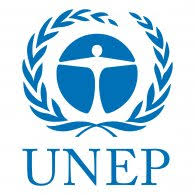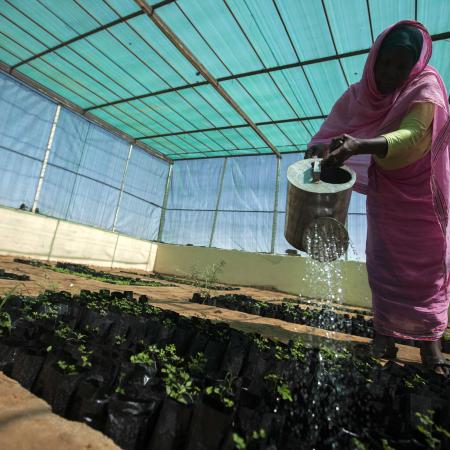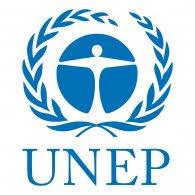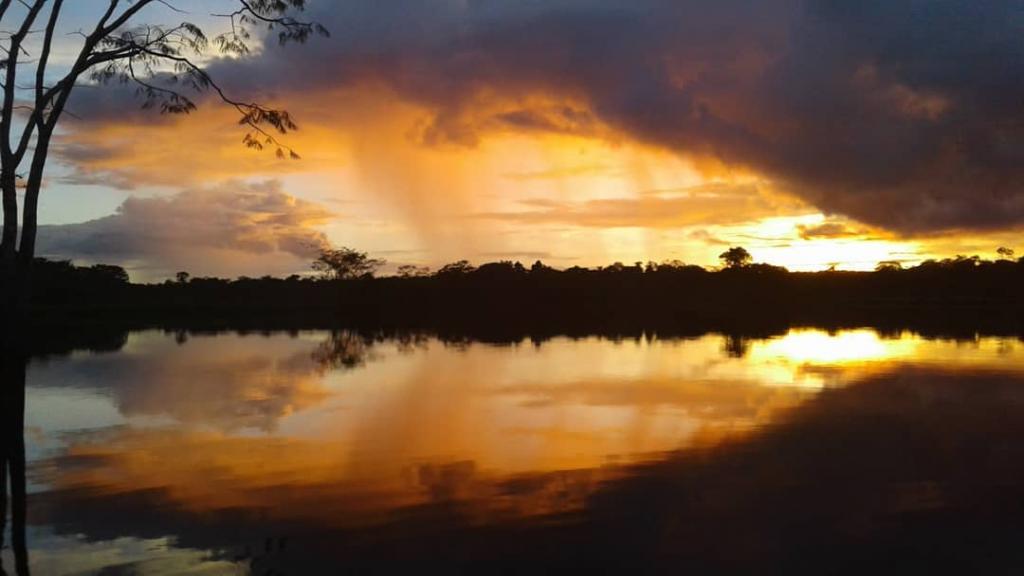
Food security and disaster resilience through sustainable drylands management

The project used a combination of ecosystem-based measures (re-vegetation and ecosystem protection) and grey infrastructure (rehabilitation of a water retention structure) to increase food security in the face of drought and flash floods, while strengthening environmental governance at the local level. Using a green-grey hybrid approach is probably the most appropriate approach in the dryland context of Sudan.
The project took an ecosystem-based disaster risk reduction (Eco-DRR) approach working within a framework of hazards (drought and flash floods), vulnerability (due to conflict zone and unsustainable practices) to reduce disaster risk (e.g. famine). However, drought and erratic rainfall is increasing due to climate change and thus the ecosystem-based measures undertaken also enable adaptation (thus are also EbA).
Context
Challenges addressed
Dafur faces drought and flash floods which are worsening due to climate change and desertification. There is also a backdrop of political unrest and conflict. A rebel group was in control of the area from 2004-2011. The area now is relatively peaceful although security is unstable with the occasional rebel attack.The wider Dafur conflict displaced people and also exacerbated unsustainable use of natural resorces, which has resulted in tension and conflict between resource uses (e.g. between farmers and pastoralists).
Beneficiaries
17,500 inhabitants out of a total population of 30,000 in five villages (Eid El Beida, Abudelik, Bahr Omdurman, Wad Kota, Waa’dha) in the Kilimondo locality, North Darfur.
Location
Process
Summary of the process
Building partnerships and community engagement (building block 1) are the underlying foundations for implementing appropriate field interventions (building block 2) and improving natural resource governance (building block 3). Finally, developing capacity at the local and national level for ecosystem-based measures (building block 4) ensures the sustainability of the interventions.
Building Blocks
Building partnerships and community engagement
Building strong partnerships at the local and national level and working with the local community is essential for the implementation and overall success and sustainability of the project.
Furthermore it was essential to connect the local communities to government bodies and ensure the state takes joint ownership of the activities so that any future support that is needed can be sought from the government.
Enabling factors
UNEP had strong longstanding partnerships (with local stakeholders and local and national implementing partners) in place in the project area.
Lesson learned
In a fragile context like in Sudan, having long standing partnerships are vital for the success of the project.
During implementation of community based activities it was learned that community level projects must make it least demanding of time and energy from community members, and ensure the right timing of activities to match communities’ schedule, as project activities generally require voluntary work.
Moreover, when communities see clear evidence of the benefits of the interventions, they then become more willing to implement and continue with similar activities on their own in the future. Interventions that show less direct livelihood benefits require good dialogue and awareness raising campaigns.
Field interventions
The field interventions were:
- Rehabilitation of a water structure for increased cultivation and greening of the wadi (grey infrastructure)
- Establishement of community tree nurseries
- Community reforestation
- Re-seeding of pasture land
- Soil erosion control to address the gully erosion problem in the area (though terracing and check dams with local material)
All were undertaken with community participation. Womens' groups manage the tree nurseries and community forests. Four of the five forests were established using seedlings from the nursery, while the natural forest in one village was rehabilitated and is being protected from livestock grazing.
Enabling factors
There was a strong uptake by the local community who contributed substantially with in-kind labour for the field interventions that clearly were beneficial for them.
Lesson learned
Designing the right ecosystem-based interventions was challenging due to the limited water availability and young vegetation is more vulnerable to dry spells. Access to water and improving livelihoods were therefore the priority. Indeed any planted trees would be cut down if livelihoods were not also improved by other means. Thus a combination of grey and green infrastructure was necessary. Rehabilitating a water retention structure along with improving agricultural yields and then re-greening the landscape while removing pressure away from the more fragile soils.
Protecting the newly planted forests from grazing was not always easy. After discussion with the community it was agreed to put in place a rotating monitoring system to ensure vigilance against uncontrolled grazing. Future projects could benefit from selecting forestry species that require minimum protection, for example unpalatable trees and shrubs.
Natural resource governance
The project aimed to improve governance of land and water resources at the community-level in order to enhance community resilience to water hazards and promote sustainable drylands management. This entailed several measures:
- Establishment of a water resource management committee that is responsible for the water retention structure, for undertaking early warning and preparedness for flood and drought; and for ensuring that water is proportionally distributed. The committee also liaises with wider landscape management programmes and the government and NGOs.
- Demarcation of the migratory route for pastoralist communities in order to reduce potential conflict over animals entering farmlands, and farms encroaching into rangelands.
- Establishment of revolving funds for agriculture (seed bank) and livestock drugs to sustain livelihood activities and provide continued services over the longer term period.
Enabling factors
The Eco-DRR project complemented another larger initiative by UNEP, known as the Wadi El-Ku Catchment Management (WEK) Project in North Darfur, implemented along the same wadi and roughly at the same time. The WEK project demonstrate how effective and inclusive natural resource management can improve relationships over natural resources, therefore contributing to peace-building and improving the livelihoods of conflict-affected communities.
Lesson learned
Natural resource governance requires stakeholder dialogue to understand needs of the communities involved and for successful implementation of the measures. Furthermore, involving necessary authorities (e.g. linking the water management committee to government and NGOs for technical assistance and finance; and involving government and all relevant stakeholders for the demarcation of the migratory route) helps to ensure sustainability of the project. Having these activities replicated through other projects (e.g. WEK and other projects) is also important. Indeed the demarcation of the migratory route was extended from the 10KM to a total of 120KM route.
Local and national capacity building
The project invested significantly in capacity building at the local and nation level through awareness raising on EbA/Eco-DRR, hands on field learning activities and training workshops. The project ensured that women were among those trained in all activities.
Local capacity building targeted mainly the five villages where the interventions took place but also involved representatives from villages who were involved in up-scaling the project interventions to a larger area of the wadi in the upstream section. Awareness raising promote dialogue on dryland ecosystems and disaster risk management issues.
Farm extension agents (2 in each village) were trained due to limited presence of the Government in the villages to provide agricultural extension support services. Moreover, eight community animal health workers also referred to as “paravets”, were trained on animal husbandry, treatment, animal drugs, feeding, and vaccination, through theoretical and practical sessions. The "paravets" also monitored the re-seeded pasture areas.
A national and a state-level training on Eco-DRR were also undertaken.
Enabling factors
The major portion of capacity building took place in the field, as part of “learning by doing” through implementation of field interventions such as nursery establishment and management, rangeland re-seeding, and reforestation.
Lesson learned
Local capacity-building trainings provided to communities improve the chances of continuity in the management of field interventions.
The State-level workshop initiated a series of dialogues in North Darfur on the importance of establishing a forum that serves as a platform for natural resource management that is both inclusive and conscious of water-related hazards. Undertaking such trainings at the national and state-level, help mainstream ecosystem-based measures in national policies and programmes. Indeed IWRM was identified as a key measure to reducing disaster risks and adapting to climate change and weather extremes, which was reflected in the National Agenda for Action which was the main output of the national training.
Impacts
The project improved food security and reduced vulnerability to drought for 17,500 people. Thanks to the improved water retention system, the increased harvest during a good rainfall year in 2014 helped to bridge the food gap caused by the failure of the rainy season in 2015. Increased land for crop cultivation also targeted vulnerable households and helped them benefit from enhanced agricultural production all while reducing pressure on the surrounding landscape.
Environmental resilience was also increased with the establishment of community forests and pasture land re-seeding. This gave protection from erosion, revegetation and re-greening of the landscape all while providing extra household income in the future from gum arabic harvesting.
Conflict over natural resources was reduced through the creation of a water management committee, the demarcation of a migratory route for pastoralists and regular stakeholder consultations.
Sustainable Development Goals
Story

Populations along a seasonal waterbody in North Dafur suffer from drought and flash floods that impacts their food security and livelihoods and live in the backdrop of conflict in Darfur. Environmental degradation due to the interplay of the periodical erratic rainfall, which is increasing with climate change, and population pressure, unsustainable farming, deforestation and overgrazing have reduced the capacity of the drylands to support local livelihoods. Conflicts over water use and resources also occur between pastoralist groups and farming communities.
The project, funded by the European Commission, led by UNEP and Practical Action Sudan between 2012-2015, partnering with local communities and the state government, won the 2017 Land for Life award for improving food security and disaster resilience and reducing community tensions through sustainable management of dryland areas of North Dafur.
The project’s many activities in Wadi El Ku included a combination of green and grey infrastructure.
Prior to the rehabilitation of an existing water retention structure (a grey infrastructure measure), a social and environmental impact assessment was undertaken to identify and mitigate any potential negative impacts. This structure will also improve water infiltration into the soil, increase crop productivity, and avoid gully erosion downstream, while bringing 6300ha of fertile wadi land (rather than the fragile surrounding landscape) under cultivation, boosting agricultural production. The local community voluntarily helped this work of rehabilitation, increasing their sense of ownership.
Green infrastructure measures were community forests and rangeland rehabilitation. A local tree nursery, managed by a woman's group, was established to support community forestry and household agroforestry while re-greening the landscape. Indeed four community forests were established in four villages (also managed by women), while in one village a natural forest was placed under protection. 1214ha of pastureland was reseeded.
Natural resource governance was improved through:
- establishment of a water resource management committee;
- demarcation of the migratory route for pastoralist communities; and
- establishment of revolving funds for agriculture and livestock drugs.
Finally, capacity was built at the local and national level on these measures through awareness raising, training workshops and hands-on learning activities in the field demonstration sites.












